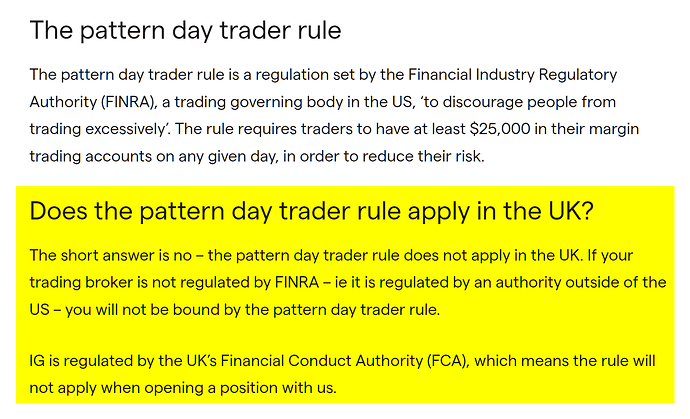Did you know that some day traders feel like they're playing a game of "Hot Potato" with their trades, constantly dodging the PDT Rule? This article dives into the ins and outs of the Pattern Day Trader (PDT) Rule, outlining its limitations and how it impacts trading strategies. You'll learn effective methods to avoid violating the rule, including the pros and cons of opening multiple accounts and exploring broker options that don't enforce PDT restrictions. We’ll also discuss cash vs. margin accounts, the potential of swing trading, and legal ways to navigate around these limitations. With insights from DayTradingBusiness, you’ll be equipped with strategies and tools to optimize your trading while staying compliant.
What is the PDT Rule and how does it limit trading?
The PDT (Pattern Day Trader) Rule requires traders with less than $25,000 in their account to limit their day trades to three within five business days. It automatically restricts accounts from executing more than three day trades unless the account balance exceeds $25,000. To avoid this, traders can use a cash account instead of a margin account, wait until their account balance exceeds $25,000, or spread out trades over multiple days to stay under the three-trade limit.
How can day traders avoid violating the PDT Rule?
Day traders avoid violating the PDT Rule by maintaining a minimum of $25,000 in their trading account. If they have less, they can't execute four or more day trades within five business days without risking a restriction. To stay compliant, traders can:
– Use a cash account instead of a margin account.
– Limit trading to three or fewer day trades per week.
– Open multiple accounts to spread out trades.
– Wait 90 days for restrictions to lift if flagged for pattern day trading.
– Consider trading less frequently or focusing on swing or position trading.
What are the best strategies to bypass PDT restrictions?
To bypass PDT restrictions, open a new brokerage account with a different firm or a different account type that isn’t subject to PDT rules, like a cash account. Use multiple accounts and hedge your trades across them. Wait 90 days before trading again after your pattern day trader status is triggered. Keep your trading volume below four day trades in five business days. Consider switching to longer-term investing to avoid frequent day trades. Use pattern day trader exemptions if available, like trading with a margin account that qualifies. Be mindful of your trading frequency to stay under the PDT threshold.
Can opening multiple accounts help me avoid the PDT Rule?
Opening multiple accounts doesn’t help you bypass the PDT rule. The pattern day trader (PDT) rule applies to all your accounts combined if you execute four or more day trades within five business days with less than $25,000 in your account. To avoid the PDT rule, you need to maintain a minimum of $25,000 in a single account or use cash accounts.
How does pattern day trading affect my trading options?
Pattern day trading (PDT) limits your trading options by restricting you to six day trades within five business days if your account is under $25,000. To avoid PDT rule limitations, keep your account balance above $25,000 or trade with a cash account, where you won’t be subject to the pattern day trader rule. Alternatively, trade less frequently or use options strategies that don’t count as pattern day trades.
Are there broker options that don’t enforce the PDT Rule?

Yes, some brokers allow you to avoid the PDT (Pattern Day Trader) rule by offering cash accounts or no minimum equity requirements. For example, some non-regulated or offshore brokers don’t enforce the PDT rule. Alternatively, trading futures or forex, which aren’t subject to the PDT rule, also bypasses it. However, using cash accounts with less than $25,000 can limit your trading activity, so choose brokers that offer cash or non-PDT accounts if you want to avoid the rule.
What are the risks of trying to circumvent the PDT Rule?
Trying to circumvent the PDT rule risks account suspension or termination by your broker. It may lead to regulatory penalties or account restrictions. Brokers monitor for pattern day trading violations, and attempts to bypass rules can result in loss of trading privileges.
How do cash accounts differ from margin accounts regarding PDT?
Cash accounts aren’t subject to the Pattern Day Trader (PDT) rule, so you can’t be flagged as a PDT. Margin accounts trigger the PDT rule if you execute four or more day trades within five business days, provided your account is under $25,000. To avoid PDT limitations, use a cash account, which limits your trades to settled funds, preventing the pattern recognition that activates PDT restrictions.
Can using a foreign broker help avoid the PDT Rule?

Using a foreign broker can help avoid the Pattern Day Trader (PDT) rule because the PDT rule only applies to U.S.-based brokerage accounts. If you trade through a foreign broker not subject to U.S. regulations, you won’t be restricted by the PDT rule’s 25-trades-in-5-days limit. However, this may come with higher fees, less regulation, and increased risk.
What is the 3-day trading rule and how is it related?
The 3-day trading rule states you need at least $25,000 in your account to day trade more than three times within a five-day period. It’s related because if you violate this rule without the required funds, your account gets flagged as a pattern day trader (PDT), limiting your trading activities. To avoid PDT restrictions, keep your account balance above $25,000 or trade with a cash account to bypass the rule.
How can swing trading help me stay within PDT limits?
Swing trading helps you avoid PDT limits by holding positions for more than one day, so you don’t need four or more day trades within five business days. Instead of executing frequent daily trades, you can focus on longer-term moves, reducing the risk of hitting the pattern day trader rule. This way, you stay under the 25,000 USD account minimum required for active day trading.
Are there legal ways to bypass the PDT Rule?
No, there are no legal ways to bypass the Pattern Day Trader (PDT) rule. It’s a regulation by the SEC requiring traders with less than $25,000 to follow specific trading limits. To avoid PDT restrictions legally, you can:
– Keep your account balance above $25,000.
– Use a cash account instead of margin.
– Trade futures or forex, which aren't subject to PDT rules.
– Limit your trades to fewer than four day trades within five business days if your account is under $25,000.
How does the pattern day trader status get assigned?
Pattern day trader (PDT) status is assigned when you execute four or more day trades within five business days in a margin account, provided those trades make up over 6% of your total trading activity. If you meet this threshold, the brokerage labels you as a PDT, requiring a minimum account equity of $25,000 to continue day trading without restrictions.
Learn about How to Transition from Pattern Day Trader to Longer-Term Trading?
Can I convert my account to avoid PDT restrictions?
No, you can't convert your account to bypass PDT restrictions. The Pattern Day Trader (PDT) rule applies to margin accounts with less than $25,000 equity. You can avoid PDT limits by maintaining $25,000 or more in your account or trading with a cash account and settling funds before trading again.
What tools or software can help manage PDT limitations?
Tools like Hootsuite, Buffer, and Sprout Social can schedule and automate posts, helping you stay within PDT rule limits. Some CRM platforms, like HubSpot or Mailchimp, also manage email campaigns to avoid over-sending. Using these tools ensures you stay compliant by controlling the volume and timing of your outreach.
Conclusion about How to Avoid the PDT Rule Limitations?

In conclusion, navigating the limitations of the PDT rule requires a strategic approach. By understanding the intricacies of your trading account, leveraging swing trading, and considering broker options, you can effectively manage your trading activities. Remember that while there are legal ways to bypass these restrictions, it’s crucial to weigh the risks involved. For more insights and guidance on trading strategies, DayTradingBusiness is here to support your journey.
Sources:
- Photodynamic Therapy in Refractory Mycosis Fungoides: A ...
- Photodynamic therapy: An emerging therapeutic modality in dentistry
- Anti-disturbance state estimation for PDT-switched RDNNs utilizing ...
- Non-fragile output-feedback control for time-delay neural networks ...
- Lowering thresholds for speed limit enforcement impairs peripheral ...
- Drug delivery challenges and formulation aspects of proteolysis ...